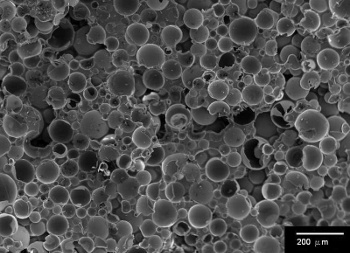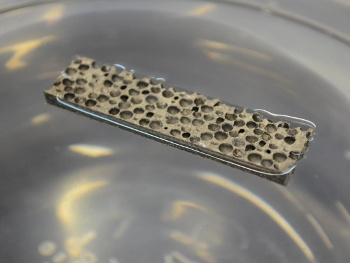Low-Density Syntactic Foam Alloy
June 18, 2015
Members of
my generation are
nostalgic about how simple our lives were in the days before rampant
technology. One sure way of assessing the
quality of life of people is through their
literature, and the predominant literature of my
childhood was the
Bazooka Joe comics found in
Bazooka bubble gum. The
jokes in these comics were simple; and, to use an expression from that era, "
cornball."
In one memorable strip, Joe and his pal, Mort, are walking past a
plumbing supply store, where they see the
sign, "
Cast Iron Sinks." Commenting on the sign, one of them says, "That's silly. Everyone knows that!" Indeed, one of the first things a
child learns about
nature is that "heavy" things will sink in
water, although this applies when "heavy" refers to
density, not
mass.
 | Density figured into a popular product of that era, Ivory soap. Ivory soap floats on water since the soap's density has been decreased by incorporating tiny bubbles of air. The density of Ivory soap is about 0.9 g/cc, while the density of most others is slightly above 1.1.[1]
(Left, a modified Wikimedia Commons image.) |
Ivory soap was famous for more than just floating. In the late
nineteenth century, the company commissioned a
chemical analysis of their soap. The resulting
slogan, "99 44⁄100% Pure," unintentionally initiated discussions of what the remaining 56/100% might be.
There are many examples of
materials having air added to their composition to make them lighter, softer, or more
thermally insulating. Two of these,
bubble wrap and
Styrofoam, are found in nearly every
office, and
polyurethane foam is used as the padding material for
seat cushions. A team of
scientists and
engineers from the
New York University Polytechnic School of Engineering (Brooklyn, New York),
Deep Springs Technology (Toledo, Ohio), and the
U.S. Army Research Laboratory (Aberdeen Proving Ground, Maryland) decided to apply the same principle to the creation of a lightweight
composite alloy.[2-3]
What they created was a
matrix of the
magnesium alloy, AZ91D, infiltrated with hollow
spheres of
silicon carbide. This alloy, a
syntactic foam, has a density of 0.97 g/cc, so it will float on water (see photograph).[2] A syntactic foam is any matrix material, usually a
polymer, that's filled with
microballoons of another material. This is the lowest density
metal matrix syntactic foam to be created, and it has the desirable property that it will absorb
elastic energy at high
compressive strain rates.[2]

A Scanning electron micrograph of an epoxy matrix syntactic foam filled with glass microballoons
(Via Wikimedia Commons.)
Syntactic foams using a polymer as a matrix are common, and these foams are being developed to replace metal components in
automobiles and
watercraft. The magnesium alloy foam is as lightweight as the polymer foams, while offering better
material properties.[3] Says
Nikhil Gupta, a
professor in the
Department of Mechanical and Aerospace Engineering of the NYU School of Engineering, and a
co-author or the study,
"This new development of very light metal matrix composites can swing the pendulum back in favor of metallic materials... The ability of metals to withstand higher temperatures can be a huge advantage for these composites in engine and exhaust components, quite apart from structural parts."[3]
The magnesium alloy foam shares the lightness of foams, but it it has substantial
strength. The enabling agent for the foam is the lightweight silicon carbide hollow spheres
developed and
manufactured by Deep Springs Technology of Toledo, Ohio. Such spheres withstand a 25,000
pounds/square inch (170
MPa)
compressive stress.[2-3] The syntactic foam can be customized through use of different
concentrations of the silicon carbide hollow spheres.[3]
The hollow silicon carbide particles also absorb
fracture energy, thereby enhancing
impact resistance.[3] At high strain rates, the syntactic alloy failed from fracture of the hollow spheres,
plastic deformation of the magnesium alloy matrix, and the fracture of
intermetallic precipitates at the
grain boundaries of the alloy.[2] Fracture of the intermetallics aided in the fracture energy absorption.[2]

The NYU AZ91D metal matrix syntactic foam, a lightweight magnesium alloy, floating on water.
(NYU Polytechnic School of Engineering image.)
This metal syntactic foam was developed as a replacement for polymer matrix composites when used in applications needing a material with
dimensional stability and
mechanical property retention at high temperatures.[2-3] Intended applications are for
vehicle armor, and automotive and
aerospace components.[3] The
Ultra Heavy-lift Amphibious Connector (UHAC) vehicle being developed by the
U.S. Marine Corps could benefit from such a light weight and high
buoyancy material.[3]
Those readers with a
chemistry background might be wondering how it's possible to create a useful alloy from magnesium. The
chemical element, magnesium, is an early member of the
alkaline earths (Group 2 of the
periodic table), so it's highly
reactive and highly
flammable. Just as alloying
lead with
tin to form the
solder alloy reduces the
chemical activity of lead to make it
safer to use,
aluminum does the same for magnesium when alloyed.
Since magnesium-aluminum alloys are extremely lightweight, magnesium is the third most used metal, behind
iron (no. 1) and aluminum (no. 2). In 2014, 907,000
metric tons of magnesium were produced worldwide.[4] The following
graph illustrates the major uses of this metal.

Historical uses of magnesium in the United States, 1975-2003. (U.S. Geological Survey.)[5)]
References:
- According to its Materials Safety Data Sheet, the density of Zest bar soap is 1.14 g/cc, and it contains sodium tallowate, sodium alkyl glycerol sulfonate, magnesium cocoate, sodium cocoate or palm kernelate, water, sodium chloride, coconut or plam kernel fatty acid, fragrance, titanium dioxide, pentasodium pentetate, tetrasodium etidronate, and color agents.
- Harish Anantharaman, Vasanth Chakravarthy Shunmugasamy, Oliver M. Strbik III, Nikhil Gupta, and Kyu Cho, "Dynamic properties of silicon carbide hollow particle filled magnesium alloy (AZ91D) matrix syntactic foams," International Journal of Impact Engineering (In Press, April 30, 2015).
- A Metal Composite that will (Literally) Float Your Boat, New York University Press Release, May 12, 2015.
- Mineral Commodity Summaries 2015, U.S. Department of the Interior, U.S. Geological Survey, January 30, 2015 (2.4 MB PDF File).
- Thomas D. Kelly, Grecia R. Matos, et al., "Historical Statistics for Mineral and Material Commodities in the United States," U.S. Geological Survey, Data Series 140, 2014.
Permanent Link to this article
Linked Keywords: Baby boomer; generation; nostalgia; nostalgic; technology; quality of life; literature; childhood; Bazooka Joe; comics; Bazooka; bubble gum; joke; cornball; plumbing; supply store; sign; cast iron; sink; child; nature; water; density; mass; product; Ivory soap; microbubbles; tiny bubble; air; Wikimedia Commons; 19th century; nineteenth century; analytical chemistry; chemical analysis; slogan; material; thermal insulation; thermally insulating; bubble wrap; Styrofoam; office; polyurethane foam; seat cushion; scientist; engineer; New York University Polytechnic School of Engineering (Brooklyn, New York); Deep Springs Technology (Toledo, Ohio); U.S. Army Research Laboratory (Aberdeen Proving Ground, Maryland); composite material; alloy; matrix; magnesium; sphere; silicon carbide; syntactic foam; polymer; glass microsphere; microballoon; metal; elastic energy; compressive strain; rate; scanning electron micrograph; epoxy; automobile; watercraft; material properties; Nikhil Gupta; professor; Department of Mechanical and Aerospace Engineering; co-author; pendulum; temperature; engine; exhaust; structural material; strength; research and development; manufacturing; manufactured; pounds per square inch; pounds/square inch; pascal; MPa; compression; compressive stress; concentration; fracture; energy; toughness; impact resistance; plasticity; plastic deformation; intermetallic; precipitation hardening; precipitates; grain boundary; bulk modulus; dimensional stability; mechanical property; vehicle armor; aerospace; DARPA Captive Air Amphibious Transporter; Ultra Heavy-lift Amphibious Connector; United States Marine Corps; buoyancy; chemistry; chemical element; alkaline earth metal; periodic table; chemical reaction; reactive; flammability; flammable; lead; tin; lead solder alloy; thermodynamic activity; chemical activity; safety; aluminum; iron; metric ton; Cartesian coordinate system; graph; history; historical; United States; U.S. Geological Survey; Materials Safety Data Sheet; Zest.